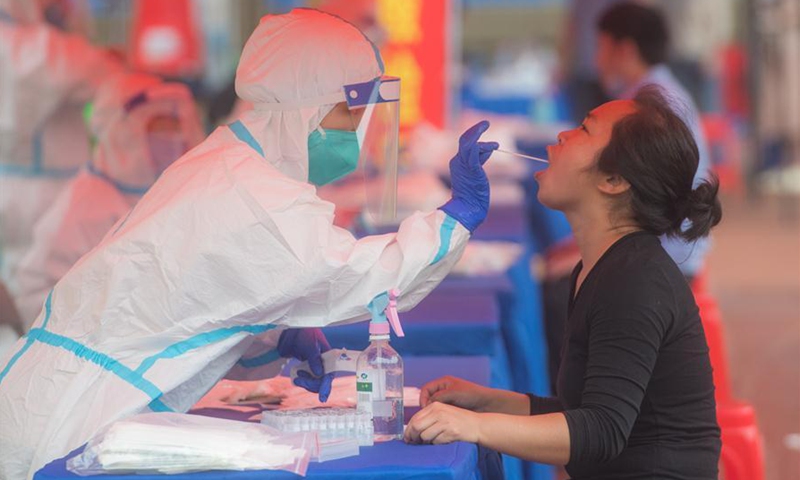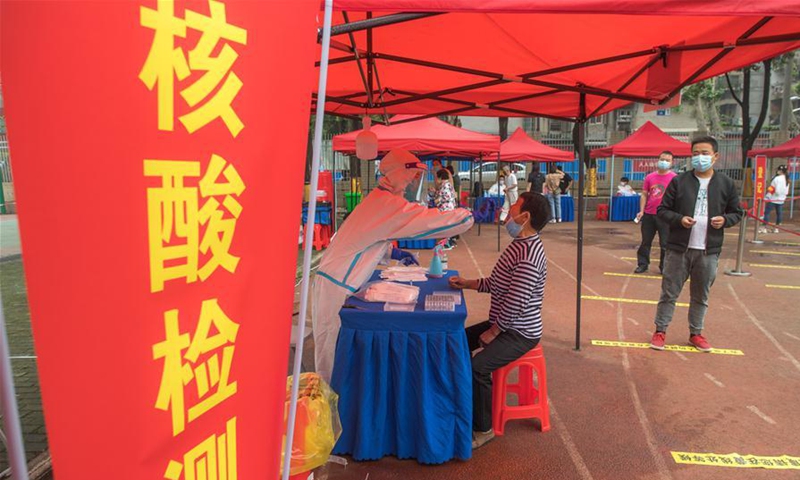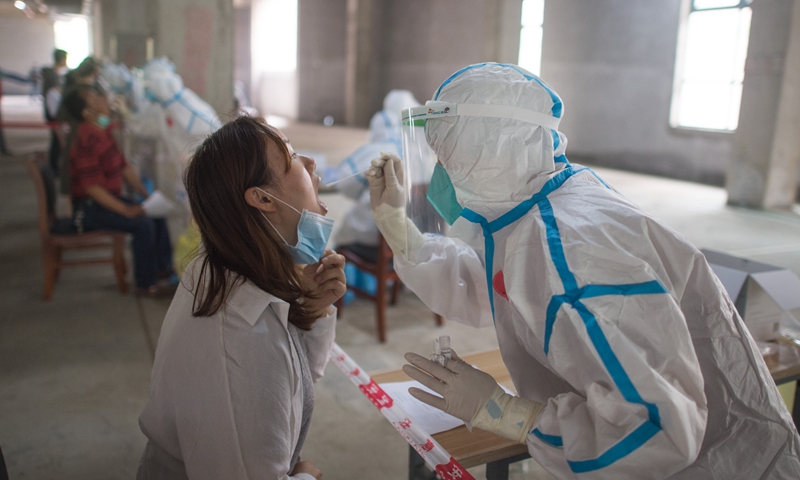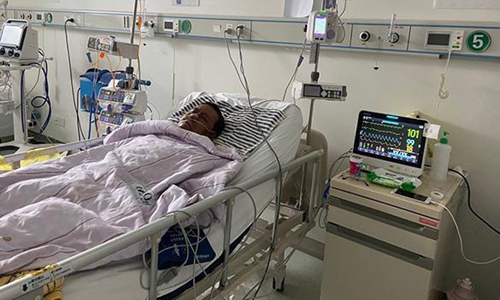
A resident takes the nucleic acid test at a testing post set up at a primary school in Dongxihu District in Wuhan, central China's Hubei Province, May 15, 2020. Wuhan arranges nucleic acid tests for all residents who have not been tested before, in order to better know the number of asymptomatic cases of the novel coronavirus. The decision was made as the virus-ravaged city continued to report daily increases of asymptomatic infections, which raised concerns among the public. Photo: Xinhua
The Wuhan city government on Tuesday released the results of its 10-day citywide test. A total of 300 asymptomatic patients were found after 9,899,828 residents were tested in the city, with no confirmed COVID-19 cases. The test cost 900 million yuan ($126 million), which will be shouldered by the Wuhan government.The results not only whisked off foreign media such as the New York Times and Washington Post's baseless accusations that there were massive numbers of asymptomatic virus carriers in Wuhan, but expert also hailed that the results served as an unquestionable milestone to China's virus battle, and cemented the country's phased victory over the horrifying virus.
From May 14 to Tuesday, Wuhan has tested 9.89 million residents and found no confirmed cases but only 300 asymptomatic patients, accounting for just 0.00303 percent of the total tested population, said Lu Zuxun, a public health professor at Huazhong University of Science and Technology in Wuhan.
Lu said that the percentage of asymptomatic patients is extremely low in Wuhan and they have tested those asymptomatic patients, along with items they have touched, and whisked off the possibility that those patients were contagious.
Li Lanjuan, a renowned Chinese epidemiologist, said, "Wuhan is safe, and the Wuhan people are healthy, so we need to give more care and support to Wuhan people, as they are all safe."
Wuhan spent approximately 900 million yuan ($126 million) on its citywide nucleic test, which will be shouldered by the Wuhan government, Hu Yabo, deputy mayor of Wuhan, said on Tuesday.
Hu said the test has bought relief and assurance for Chinese people in general and Wuhan people in particular, so the money was "worthwhile."
Wang Weihua, an official with Wuhan's health commission, said that to accomplish the massive test, Wuhan increased its nucleic test institutes from 23 to 63 and added more personnel to conduct the test.
The city also combined test methods from single testing with sample pooling, with no more than five samples in one group, said Wang, noting that such a measure has greatly improved testing efficiency within a short period of time.
Peng Li, a doctor in charge of testing in Wuhan's Zhongnan Hospital, told the Global Times on Tuesday that his hospital has tested more than 100,000 samples in those 10 days. "We prioritize single sample testing, while sample polling is more prevalent in those testing institutes," Peng said, adding that the inspectors sometimes worked over 12 hours a day to accomplish the tests.
With such measures, Wuhan has increased its daily testing capacity from 300,000 people to 1 million, Wang said.
In order to ensure the test's accuracy, the Wuhan health authority re-checked 35,961 samples, and found no inconformity to the previous results, said Zhang Dingyu, head of Jinyintan Hospital.
"The community workers went door to door to tell residents the time and place to get tested. And when we were lining up to test, they made sure we kept a safe distance from each other and constantly disinfected where we stood. The test took no more than 15 minutes and we got the results the following day," Zou Furong, a Wuhan resident, told the Global Times on Tuesday.
Peng Zhiyong, director of the intensive care unit of the Zhongnan Hospital of Wuhan University, told the Global Times on Tuesday that after conducting the citywide nucleic acid test, the city became more confident and began to resume works and classes.
The citywide testing shows the outstanding management and arrangement of the local government, as well as China's institutional advantage in concentrating resources to accomplish major tasks, Peng said.
As the citywide testing neared its end, many Wuhan residents posted their negative nucleic test results on social media. One Wuhan resident named Luo Ning said more and more people could be spotted at shopping malls and restaurants.
On April 8, Wuhan lifted its city lockdown, but the "psychological lockdown" of Wuhan people was lifted only after the citywide testing, Hu said.
Li Lanjuan said that Wuhan's disease control and prevention department also tested 2,314 samples of the city's drinking water, taxis, public transports and pets, which all tested negative for the novel coronavirus.

Residents take nucleic acid tests at a testing post set up at a primary school in Dongxihu District in Wuhan, central China's Hubei Province, May 15, 2020. Wuhan will arrange nucleic acid tests for all residents who have not been tested before, in order to better know the number of asymptomatic cases of the novel coronavirus. The decision was made as the virus-ravaged city continued to report daily increases of asymptomatic infections, which raised concerns among the public. (Xinhua/Xiao Yijiu)
The US pales in comparisonExperts hailed the citywide testing of Wuhan, the city hit hardest during the early outbreak of coronavirus in China, has served as a milestone of China's arduous battle against the virus, and cemented the country's phased victory over COVID-19.
A total of 50,340 infection cases were recorded in Wuhan since the outbreak, with 3,869 deaths, according to Wuhan official data released on Monday, bringing the death rate to 7.6 percent. Data in the US, whose politicians have been most vocal about China's virus battle, does not look so optimistic.
As of Monday, the US recorded 106, 176 deaths and more than 1.83 million infection cases - a death rate of 5.78 percent. In New York City, the hardest-hit place in the US, 376,520 coronavirus infection cases were reported on Tuesday, and the city has recorded 29,766 deaths since the outbreak, marking a death rate of 7.9 percent.
Data shows about 15 million people in the US have received nucleic acid testing, 4 percent of its 328 million people, while Li Lanjuan said that in Wuhan alone, 10.9 million people have been tested, accounting for almost 99 percent of the city's population.
By the end of April, the cure rate of Wuhan's coronavirus patients in critical condition has soared to 92.2 percent from 39.1 percent in February. By comparison, a cohort published in May in The Lancet said that of 257 critically ill New York City residents treated at two Manhattan hospitals, 39 percent died.
As the first wave in the US has yet to subdue, specialists have warned that the country is doomed to face another wave of infections because of large gatherings and violent protests, where protesters broke social distancing protocols to voice their anger over slow death of black man George Floyd, who died at the hands of police.
Trump used to boast of his country's testing ability, but the US has recorded the highest numbers of infections and deaths from the Trump administration's negligence in quarantine and treatment measures, said Zhang Tengjun, an assistant research fellow at the China Institute of International Studies on Tuesday.
Surveys handed out to their people by the Chinese and US governments show the differences in the two government's priorities and values. They demonstrate that the Chinese government values people's lives more and can control the virus faster. On the other hand, the US government is eager to push the restart button to the country's production and economy, which has accelerated the viral spread, Zhang said.
The US has recorded more than 1.8 million coronavirus infection cases and over 100,000 deaths so far, 722 times higher than China's, Zhao Lijian, a spokesperson for China's Ministry of Foreign Affairs said on Monday. He also quoted a New York Times report as saying the delayed response from the US government cost 36,000 lives, and if the government had taken measures two weeks earlier, 83 percent of US coronavirus deaths could have been avoided.




